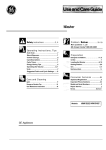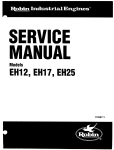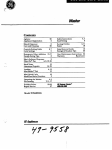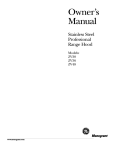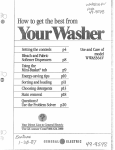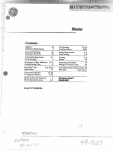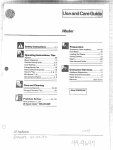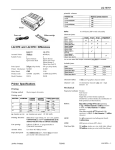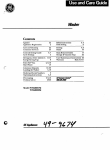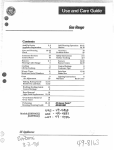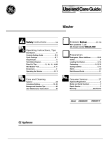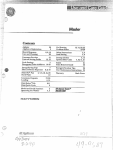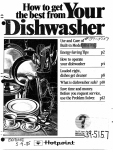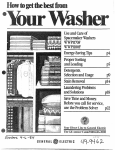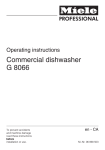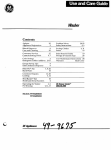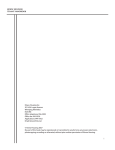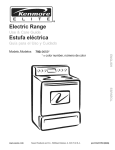Download GE WWA8806M User's Manual
Transcript
C
o
Agitator
Appliance Registration
25
2
SafetyInstructions
SoakSetting
Care and Cleaning
Consumer Services
25
27
Sorting
Stains
ControlsSetting Guide
CycleSettings
6,7
5
Detergents, Other Additives 13–17
Energy-SavingTips
10
Filter-Flo@
Pan
Hard Water
LimestoneDeposits
Loading the Washer
Model anti Serial Numbers
operating Instructions
2
4, 5
Models WWA8806M
WWA8808M
-.
14,25
4, 12
5, 9
5, 8
7, 11,17
20-24
4,11
18
19
25 ~
User Maintenance Instructions 25
BackCover
warranty
4,8, 12
16
Mini-BasketTM
Tub
hIini-QuickCycle
I)re-treatir]g
I’rol>]emSolver
StainRemovalGuide
Storage &VacationTips
3,4
~, $
GEA4nswercenter@
800.626.2000
Readthis book CarefuIly.
It is intended to help yoLloperate
and maintain your new washer
properly.
Keep it handy for answers to your
questions.
If you don’t understand something
or need more help, write (include
your phone number):
Consumer Affairs
GE Appliances
Appliance Park
Louisville, KY 40225
If you received a
damaged Washer.oo
Immediately contact the dealer (or
builder) that sold you the washer.
money.
BeforeyourequestSerticee.o
save tie
and
Check the Problem Solver on
pages 20 through 24. It lists causes
of minor operating problems that
you can correct yourself.
write
serial
down the model and
numbers.
You’1]find them on a label on the
lower left side near the front.
These number-saI-Calso on the
~onsuinel” product OWllership
i<cgis[rutionCard that canlc with
y[]ur washer. Before scndiilg in this
Cilrd,~]C;lSCwrite tilese nL1lilbcrs
Ilel-c:
To obtain service, see the
Consumer Services page in the
-I
back of this book.
We’re proud of our service and
want you to be pleased. If for
some reason you are not happy
with the service you receive, here
are three steps to follow for
further help.
FIRST, contact the people who
serviced your appliance. Explain
why you are not pleased. In most
cases, this will solve the problem.
NEXT, if you are still not pleased,
write all the details—including
your phone number—to:
Manager, Consumer Relations
GE Appliances
Appliance Park
Louisville, KY 40225
FINALLY,if your problem is still
not resolved. write:
To obtain a Spanish language
version of this book, call
GE Answer Center’g’
800.626.2000
consumer information service.
Para obtener la versi6n en
espaiiol de este manual,
name a
GE Answer Center,@
servicio de informaci6n
para el consumidor,
te16fono800.626.2000
FORYOURSAFETY
If you smell gas:
1
2
a
a
3
m
‘Don’tturnelectric switches
on or OHbecause sparks may
ignitethe gas.
L,.
,.-.,,
../i
.—.—___
.-. —..
.
I
———.,...—.,
....._______
.—
. .. ... ..
.
—___
,
—.
i}ljury topirsons when U$ing
J’Qal”appllancey follow basic
~lrecautions, including the
following:
e t~se
this appliance only foriw
intended purpose as described
in ~hisUse and Care Book.
e TMSwasher mmt be properly
imblld and located h
accordance tith the
Imtilation hstmctiom before
it k used. If you did not receive
an InstallationInstructionssheet
with your washer,yoL~
can obtain
one by contactingthe service
1ocationnearest you.
—Properly ground to Cotiorrn
with a~igoverti~g codes and
elothes9push
inthe cycle
selector
lmob to“STOP”
position,
then waituntti the
machinehas completely
stoppedbeforeopeningthe lid.
o close Supervisionk
necessaryMttis applianceis
used by or near CtildrenoDo
not allowctildren to play
inside9on or tith thk
apptianceor any dkcarded
appliance.Disposeof
tiscarded appliancesand
shippingor paeting materials
properly.Beforediscardinga
washer9or remoting from
setiee9 removethe WmherMd.
~Keep all laundry aids (such as
detergents,bleaches, fabric
softeners, etc.) out of the reach
of children, preferably in a
locked cabinet. Observe all
warnings on container labels to
avoid personal injury.
*Keep the area around and
unde~lleathyour appliances free
from the accumulation of
combustible materials, such as
lint, paper, rags, chemicals, etc.
QKeep the floor around your
appliances clean and dry to
reduce the possibility of slipping.
~To ~ninirnizethe possibility of
electric shock, unplug this
appliance fron: the power supply
before attemptmg any
maintenance or cleani~lg(except
the removal and cle~an~ng
of the
lint filter).
NOTE: Tu]lling tile Cycle
Selector knob to an OFF positio~l
does NOT disconnect tl~e
appliance from the power
supply.
ordinanew. FOI1OW
detiiis in
ImtallationImtruetions.
mtan or Stem Whereit till
be exDosedto tem~eratires
‘-- -
e NT:vqrreach intowasher
Whl!eIt ismeting.Before
loading, unloading or adding
below’fr:ezillgor exp6sedto
tile weather’
-=—--
— Connectto a properlyrated,
protectedand sized power sLlpply
cir~uitto avoid electrical
o~trload.
— Connectto ade~uater)lumbing
and drain facilities‘asde;cribed i;
the
}
I
r-.,
———.—
.--——
—.—
.. ..-
1
*Donot operatethis appliance
if it is damaged,malfunctioning,
partiallydisassembled,
orhas
missingorbrokenparts,
includinga damagedcordor
plug.
oDo not washfiberglassarticles
inyourwasher.Skinirritation
couldresult from the remaining
particlesthatmay be pickedup
For washer operation
by clothingduringsubsequent
washeruse.
~The laundryprocesscan reduce
the flameretardancyof fabrics,
To avoid such a result,the
garmentmanufacturer’scare
instructionsshouldbe followed
verycarefully.
How tooperate
your clothes
.-
.:
~Do not leavewasherlid up
duringcycle.This will stop the
wash and spin actionand prevent
completionof the cycle.
~
‘-
~~VE
THESE
IN~TRUCTION~
Wmher
reduce the risk offire,electric shock, or injury topersons, read
wAmIN&To
the mPoRTANT
SAFETY
INSTRUCTIONS
before operating
this appliance.
Wash/Spin Speeds
Water Level
>
Q
WashjRinse Temp.
tlea~
Duly &ra
Lame
Capacity
SevenCycleTwoSpeedWasher
NORMAL
t.fEDIUM *
~:::-w:E.&*:t[n
&
=
‘~.?
GmE
AUTOm
B
Smu
@
*
fit~$fK
\
m [MmloslulPJ%”to
%10,
—
1@
@d
@
SOrtiag
andLoading
@Sort clothes carefully by fabric
type, weight, color and amount of
soil, according to instructions on
page 9.
~Remove Filter-F1o’h’
pan and
Mini-Basket’’”tub. The underside
of the lid is il good place to put the
pttllwfli]e loading or unloading
clothes.
Mini-(luich Cycle
:7
o MIHI.
BASKET
~Position the Filter-Flo pan on the
agitator. Lint will collect in the pan
for easy removal when the wash is
finished.
NOTE: Do not use the Filter-Flo
pan as a wash basket. Do not put
any items to be washed in the
Filter-Flo pan,
See page 15for informationon how
:{
~
4
Extra Clean Cycf
.--= - ..
---
@Select Wash and Rinse
_pa
k:
~
Temperature.
—.
@ PLlshCycle Selector knob in
and turn clockwise to your selectecl
wash setting.
Regular Cycle—automatically
provides Normal Wash Speed and
Normal Spin Speed.
Perm Press Cyel*dLitolllatically
providesGentleWashSpeed and
GentleSpin Speed.
ZF’ -:$+$:.$,;,.
—-—————.—
-
,. ......
,..-
~ -:~,:
I1-:
rJ?
I:’
1!’
[d~g+
I
.
I
@ Pull Cycle Selector kn,>bout
to start the washer. If yoLl wish to
change set{ingafter washer h:~s
started, push Cycle Selec[or knob
in to stop ihe washer and reset ~~”--’~
)
the new position. Settings can H~_,..
‘.
,.- .
. ...-_—
___
-——
—
.—..——
——..—.—
—— —
--. ___________
... .,
“._
._.
.....__,
1
Mini”Quick
cycle—
For most cottons, linens and work
and play clothes. Two soil level
settingsare provided, but you can
set the selector in-between, if
desired.
For small, lightly soiled loads you
need in a hurry.Use with MINIBASKETn’tub only.
OFF P.PRESS
Perm3nenfPress
‘ycle~ @
k
Permanent
Press&
Knits
cycles—
For po~yesterknits, delicates and
permanent press. An extended
cool-down spray rinse is provided
to minimize the setting of
wrinkles.
OFF P.PRESS
Regular Cycles
OFF P.PRESS
Soak Cycle+ o
Permanent Press
and Knits Cycles
a
~k Cycle@ @
Mini-Quick Cycle
&
NORMALSOIL ~
IIL @
HEAW
N
START
START
soak
cycIe—
L-sewith most soaking aids to
lcosen embedded soils and stains.
See page 8.
w
Extra
clean
cyele—
For modern fabrics with heavy or
oily soil. A second rinse is
provided to help remove the
additional detergent that is
required for these soils.
and Knits Cycles
;oakGyc/u
~
SOIL @
Aw
@
Mini-Qtiick CyclI
RA PINSE
START
I
Ilrhat
. .,
Extra Clean Cycle I
Hilppens
inEachsetting
(ApproximateMinutes)
%
START
Mini-Quick Cycle
control
setting
Guide fordimerent
Waswspin
Load
speed
~ottonsandLinens
White/ColOrfast
Normal
Bright/Non-colorfast
Normal
WorkClothes,Dungarees,
etc.
HeavySoil
Normal
Average
Soil
Normal
Permanent
Press,TreatedCottons,
Blendswithcottons
Heavyoroilysoil
Normal
Averageorlightsoil
Normal
Synthetics—Polyester, Nylon,
Acrylic Knits and WovenF~brics
Sturdy
wash
fabrics
and loads
water
Temperature
Hot or Warm
Warm or Cold
Regular Cycles
Regular Cvcles
Normal or Light Soil Setting
Normal or Light Soil Setting
Hot
Hot or Warm
Extra Cleaniilg Cycle
Regular Cycles
Set at Start
Normal Setting
Hot
Warm
Extra Cleaning Cycle
Permanent Press & Knits
Cycles
Normal
Warm
Gentle
Warm
Permanent Press & Knits
Cycles
Permanent Press & Knits
Cycles
Silks, Wools; Blends of Silk
and Wool
Gentle
Warm
Permanent Press & Knits
Cycles
Rayon and Acetate
Gentle
Warm
Permanent Press & Knits
Cycles
Down-filled garments, if machine
washing is recommended
Gentle
Warm
Permanent Press & Knits
Cycles
~ormal
Hot
Regular Cycles
Warm
Permanent Press & Knits
Cycles
Knits Setting
5 min. soak
then Normal
Warm
Regular Cycles
5 min. soak then Light Soil
Setting
~ 5 min. soak
then Normal
Warm
Regular Cycles
5 min. soak then Light Soil
Setting
Hot or W~rm
Permanent Press & Knits
Cycles
Permanent Press Setting
Delicates
Permanent Press & Knits
Setting
Knits Setting
Permanent Press
Setting
I
f3ubyClothes—Sturdy, such as
Diapers. Nightgowns, Shirts, Pads
Sheets, Receiving Blankets,
Coveralls
Baby Clothes—Dclicatc
Blankets-Wool, Part-Wool,
cotton
Bltinkcts-Syllttlctic, Electric
F
Cllr[ains-l)(j NO’I’NIACHINE
WASH fiberglass
i ,>
Chcr)ile Bedspreads. Robcs:~:l’
Gentle
I-Iotor Warm
Pcrinanent Press & Knits
Cycles
Permanent Press or Knits
Setling
Slipcovers. l)riipcries, Bti[hma[s
:Ill(i [?L1~S ‘“”;”
NoriI]al
Hot or Warm
Regular Cycles
Normal Setting
IJeninls (espccia!ly Iil~ii:o BILic
JL’iillS):iildotht~fabrics tll:lt i)l~~d
Norinal
cold
Regular Cycles
or Warill
g.\.
~..
!.T:.
——’
ii:-.
~.
~-:=
Ii1
k
I
~:
~
I,
Knils Setting
Pernlaileilt Press & Knits
Cycles
i,
.)
1
...~;
[
Pcrinancnt Press or Kilils
Settiilgs cicpeil(iingon [)I1lOLIII[, “-%-~
of soil
.. ,-i.
Pcrinailei][ Press & Kili[s
Cycles
—
—
1
—.
....—...—.——.————
..-..... ,. .-..—--.—
-----.--—--——-—-———-—
.—
—
—..__
I
!
.
Bleach
-a
Liquid chlorine type.
Only non-chlorine bleach when needed.
If colorfast is unusually soiled, use hot water. Use maximumdetergent recommendedon
page 13.
White or colorfast, liquid chlorine type.
Non-colorfast, only non-chlorinebleach
when needed.
Use maximum detergent recommended in guide on page 13.
White or colorfast, liquid chlorine type.
i~on-colorfast,only non-chlorine bleach
when needed.
Small loads reduce wrinkling. Use maximum Detergent recommended in guide on page 13.
Use Extra Clean Cycle-–see page 5,
White or colorfast, liquid chlorine type.
A’on-colorfast,only non-chlorine bleach
when needed-
If unusually soiled, use hot water. Use maximum detergent recommended in guide on
page 13. Small loads reduce wrinkling.
No bleach
Wash only if recommended by the garment manufacturer. Follow instructions carefully.
Seldomneeded. If needed, use only
Ion-chlorine bleach.
Wash in your washer only if recommended by the garment manufacturer,
‘1
No
bleach
._-. ____
“1
White or colorfas[, liquid chlorine type.
You may prefer to use a mild type detergent. Do baby clothes separately. Pretreat spots.
Rinse diapers,’nightgowns, pads and sheets after use. Keep diapers in a covered pail of cold
water and conditioning agent like Borateem brand.
Only non-chlorlne bleach when needed.
You may prefer to use a mild type detergent. Do hand-knit garments by hand.
No bleach
Fill washer, add detergent, allow to dissolve before adding blanket. Do one blanket at a time.
Pretreat heavily soiled spots with liquid detergent.
IN()blcuch
On electric blanket, sew a strong piece of cloth over plug to protect blanket and washer from
damage. Do one blanket at a time, Pretreat heavily soiled spots with liquid detelgent.
Whi[c or colorfast. liquid chlorine type.
Vacuumout loose dirt before washing,
---
~
Wash frequently to fluff up the down and retain the garment’s warmth. Wash separately. Wet
down gives off an odor which maybe absorbed by other garments. Odor disappears when
garment is dry. Treat heavily soiled areas with liquid detergent or paste made of water and
granular detergent. Close zippers. Wash 2 or 3 at a time or add towels to balance.
GARMENT MUST BE TUMBLE DRIED.
1
I
I
1
\Vhilc or colorfast, liquid chlorine type.
\Vhi[c or colorfast,”liquid chlorine type.
Washonly 2 or 3 rugs or mats at one time, Shake before washing to remove excess dirt.
N() t)lcach
‘cr new “indigo blue” jeans, wash at least 3 times in very small loads with full water fill.
cans need ample room to move to avoid white lines at creases. May discolor plastic washer
)arts. Subsequent washings will reduce discolorations, but will probably never eliminate it.
‘he stained parts will not discolor subsequent washing loads.
/
I
‘urnblc on FLUFF (N() Heat)
.
..
How
tousethe
HOW to use the
@
‘ Mti”Qlliek
cycle- ‘.=-.’.‘-
soak cycle
The MINI-QUICK cycle is a short ‘______
cycle intended to wash small loads
of lightly soiled clothes you need
—
in a hurry.
——
Because this cycle is a short one
for small loads, the Mini-Basket
tub should be used for satisfactory
results.
OFFP.PRESS
flegular Cycles
Soak Cycfe @ @
NORMALSOIL @
HEAW
AUTO~RA
RINSE
STARl
~66S0AKCYCLE7’temperature
will automatically be cold.
~If hot or warm soak is
desired, set the “WASH/RINSE”
TEMPERATURE switch to
“HOT/COLD” or “WWCOLD”
and turn the Cycle Selector knob to
“Normal” in the Regular Cycles.
Start the washer. After washer fills
and begins to agitate, push in the
Cycle Selector knob and turn to
“SOAK CYCLE.” Pullout the
CycleSelectorknob tocompletethe
cycle.
oFor au extetided soak9allow the
washer to f~]land agitate for a few
minutes to dissolve the soaking
agent. Then push in the Cycle
Selector knob to stop the washer
(keep lid closed) and allow to soak
for as long as desired. After
desired soak period, pull out the
Cycle Selector knob to complete
[hc cycle.
g Do not use the Mini”B:tsket tub
with tile soak cycle.
. ..,
~_
—.—
‘.—=
The Filter-Flopanhas two
functions:
@LINT FILTER-Position the
Filter-Flo pan on the agitator after
loading clothes into the washer.
Lint is easily seen and removed
after the wash is finished.
~LID FOR THE M~IBASKET-After loading the
clothes in the Mini-Basket tub, be
sure to replace the Filter-Flo pan.
The pan serves as a lid to keep the
clothes in the Mini-Basket tub.
NOTE: Do not use the Filter-Flo
pan as a wash basket. Do not put
any items to be washed in the
Filter-Flo pan. Do not place
detergent packets in the Filter-Flo
pan.
—.——-—.—-.——-.—
.... ... ....... ..=. ...-————
————
OFF P.PRESS
Cle @
Permanent Press
and Knits Cycles
a
I
!
&
Mini- f?uickCycle
START
~ Push the Cycle Selectorknob in
and turn it clockwiseto the MINIQUICKcycle.
~Pull the Cycle Selector knob to
~=z.
start the washer.
e+4:’-
—.
.—.———.——.
.--.—
---.... ... .
:-;:
-
_....-..!
Here’s how to use the Mini-Basket
tub:
@Remove Filter-Flopan.
can be washed inthe
Mini-Basket
tub:
@Close lid and set controls as
follows:
-–Set Water Level to “MINI-
BASKET”position.
o Small loads of regular fabrics...
up to 2 pounds.
~Delicate loads such as lingerie,
panty hose, girdles, blouses,
sweaters, socks, shirts, baby
clothes and other small, delicate
hand washables.
o Stuffed toys.
QTennis shoes.
some
special
instructions
to remember whenyouuse
tl?e
Nlini-Baskettub:
e Do not wash clothes in the
regular basket when using the
Mini-Basket tub.
o not use the Mini-Basket tub
the Soak setting.
QWhen washing stockings, panty
hose and other easily tangled
items, always handle separately. To
minimize tangling, the use of a net
laundry bag is recommended.
~Place Mini-Basket tub on
agitator. Pull the agitatortoward
the front of the machine for easier
installation and removal of MiniBasket tub.
~Put 1/4 to 1/3 cup (60 to 80 ml)
detergent in the bottom of the
Mini-Basket tub.
e Load clothes in Mini-Basket tub.
See page 9 for sortinghelp.
—Select desired Wash/Rinse
Temperature and Cycle.
See page 4.
—Pull out Cycle Selector knob
to start washer.
0 After loading clothes in the MiniBasket tub, be sl{reto i“eplacethe
Filter-l~lopail. The pan serves as a
lid to keep the clothes in the MiniBasket tub.
-.--%
--.,
,.J
=@
.__.:
....
‘i.
>.
(,
..—..——
——.—..—.
.——
——..
”....-
._-..
-
——.—...—
.—
-----
.
..=
—-—..
.,__
.__.
__..
;
:, ,
_.
If yotlr clothes and household
items don’t look clean ~andfresh
after washing, you will probably
re-wash them... and that means
you’ll waste energy. Remember to
sort your clothes carefully and load
thenl properly, select correct
cycles, use enough detergent and
c~zoosea water ternperatllrewarm
eiloligllto releaseand get rid of
soil.
QUse Hot Wash—up to 150°F.—
on a regldar basis onl)~when
washing heavily soiled articles—
such as work and play clothes.
~Undernormalsoul conditions,
wash in water above 80”F.(27”C.).
This generallymeans usingthe
WarmWashtemperaturesettingon
your washer—temperatures
approximate]y 90° to 11O°F.or hand
comfortable.If you noticethat soil
has accumulatedafter several
consecutivewashings,use Hot Wash
occasionally.if safe for fabrics.
----i
—
. ...—_.—-_
.—._.__._..,..”,.
”___
“
,, ,. ~..
~Try to wash less often. Save
articles of the same type of fabric
until you have a full load.
IJIf you must wash smaller loads,
adjust the amount of water. Small
loads should have lower water
levels.
@Wash in off-peak utility hours.
Your local utility can tell you
which are the off-peak hours.
*Use Normal Spin Speed to
remove more water and help lessen
drying time. The dryer will remove
any wrinkles caused by the Normal
Spin.
o Use your Mini-BasketT”
tub for
very small loads. It uses less water
than the small water level in the
big tub on this washer. You Wi]l
also save on detergent and energy.
_-,
._.
-_._.-<
.,
““...
.
. .
.“.
. ..-
.
.
..-
—,—
-
-
~—
—.—
——..——.—...—
.._-.
._
\
It pays tocheck and prepare
clothes for
washing.
Separate
IDEmpty pockets, brush out cuffs,
zip zippers, snap snaps, hooks and
buttons.
(
from
from
w
c
w
.
(
sortby color
more information on lint
rol, see page 18.
Separate
sortby fabric
(
Separate
[
from
* Turn Poly Knits inside-out to
minimize fabric surface damage.
Soaking and Px=e-treating—
a good way to loosen deep soiis
and Shins.
A thorough soaking with detergent
or special soaking agent is another
way to remove heavy soils,
embedded dirt and even some
stains.
Soaking can be either a completely
separatewashing step or a
preliminary step to a completewash
cycle. For detailed info~lnationon
how to soak in your washer, see
page 8.
SOR Information
ON
SOAKING AGENTS, SEE
PAGE15.
*Pre-treat heavy soil by rubbing in
from
from
(
from
from
from
-——..
*Check all items for areas of
heavy soil or stain.
@Remove stains. For STAIN
REMOVAL GUIDE, SEE
PAGE 17.
from
LINT PRODUCERS—such as
terry toweling and chenille—give
up lint.
LINT COLLECTORS—such as
man-made fibers and napped
fabrics like velveteen and
corduroy—attract lint. These must
be washed separately.
~- :
QDo any necessary mending-rips,
hems, tears,
.-——.
——
a small amount of liquid detergent
or a paste made of water and
powdered detergent or soap. For
best results, wait 1/2 hour before
washing.
How’
toIoad your washer
—
special
recolnmendations
.-
‘-: _
forWashing permanentpress
if you do nothave a dryer.
--
If you are machine-washing
Permanent Press clothes that you
plan to line dry or drip-dry, use
extra care to minimize wrinkling
in the wash process:
~Be careful not to overload
washer. Permanent Press clothes
must have ample room to move
freely. A Medium size Permanent
Press load is the largest that should
be washed.
* Use more water than you would
for a regular load. Use a Medium
Water Level for a Small Load; a
Large Water Level for a Medium
Load.
~Remove clothes promptly as
soon as washer stops and hang
immediately.
~To minimize wrinkling, use the
Permanent Press Cycle:
*Load cfothes dry.
~Take a properly sorted group of
clothes and drop them loosely in
the wash basket in this order:
Large Ilems- Iikc sheets. Do not
wrap arouncithe agitator.
Snlall Itenls-Iike washcloths.
.. .,..,-...,______
—--- -——.-.-——.—.
This illustration, with clothes just
reaching the Clothes Retaining
Ring, shows a proper load. Clothes
have ample room to move because
they are not packed down, nor
wrapped around the agitator.
Clothes are loaded dry since wet
items are apt to pack down which
encourages overloading. T’hissize
load requires a full water fill.
What is tklebest size load of
Clotlles—large$medium9 or
Slnail? save tillle, energy and
detergent by avoiding extra useof
the washer. Try to wash a full load
of clo[hes, If you can it is better to
save clothes until you have a full
load. If you must wash smaller
loads, save water, energy and
de!ergt:n~by adjusting the water
ICVelI-Orthe size of the lo:]d.See
p~g~<L.
—.—.
_
To add items after
the %Vasherhas
started.
~Turn off the washer.
QCarefully remove the Filter-Flo
pan.
...
..
~“
.:,.
j,
i.!.
f:
!f
i.
i
Ik
!
\
;,
k
~
$.
~Add any additional articles by
submerging them next to the
agitator.
~Replace the Filter-Flo pan and
restart the washer.
NOTE:Do not use the Filter-Flo
pan as a wash basket. Do not put
any items to be washed in the
Filter-Flo pan. Do not place
detergent packets in the Filter-Flo
pan.
-—.
.—__
...—
:
~
[
r
— -------.....,—-.
.-—_
._--...-.r“.-...,
.4.,
-.-_..
“..
——
.-
.-
-.
Phosphate-
Advantages
Disadvantages
Perform well in hard or soft water.
Are not available in some areas.
Powdered Detergents
Wash all types of fabrics well.
Can be used in hot, warm, or
cold water.
Non-PhosphatePowdered Detergents
Perform satisfactorilyin soft
or moderately hard water.
Generally do not clean well in
hard water.
In some areas only non-phosphate
products are available.
May be difficult to dissolve,
especially in cold water.
Should not be used in cold water.
Those containing sodium
carbonate as an ingredient may
cause harmful limestone deposits
on clothes and washer when
combined with hard water.
(See page 12.)
‘~
Liquid Detergents
Perform well in soft water.
Offer better performance in
hard water than powdered
non-phosphate types.
May not perform as well as
powdered phosphate products
when diluted in wash water.
Clean synthetics and fabric
blends well.
Are excellent as concentrates
for removing spots.
Completely dissolve even in
cold water.
Perform well in soft water.
Generally do not clean well in
medium-hard or hard water.
IMaycombine with water
hardness minerals to form
sticl<ysoap cllrd.
‘.
“!
)
——
—
The
resdk
ofconthued
use ofcarbonate
—
—
detergents
Is your water hard? If it is, and if
you use a carbonate type nonphosphatedetergent,you will most
probably notice limestone*
deposits on your clothes and
washer surfaces.The hmdness of
your water and your washing
frequency will determinehow
rapidly the limestone will build up.
If your water is VERY HARD
(11or more grains) and if you
--wash just a few loads a week, you
may see limestonebuildups in just
a few months.
Effects on clothes
Recommended methods to
reduce limestone buildups
@Increaseuse of bleaches,presoaks,
packagedwater conditioners,
prewash soil and stainremoversto
help in removingstubbornsoils
and stains,
Although limestone buildup occurs
more rapidly on cotton, it will
eventually affect various fabrics in
the following ways:
oGives a stiff, harsh, rough feel to
fabrics such as toweling.
~Causes colors to fade and become
dull and dingy.
@Causes graying of fabrics.
~Leaves a white, powdery residue
on dark-colored items.
~Causes spot-fading of bright
colors as a result of direct contact
with detergent.
~Reduces wrinkle-resistance of
permanent press fabrics.
~Destroys effectiveness of flameretardant finishes on cottons such
as children’s s]eepwear,
@1ricreasesfi~bricwear because of
the scrubbing action between
limestone deposits on the fabrics
(lLlringwasher agittltioll.
~ ~nsightly buildup on a]l washer
sLlrfaccsCxposedto the wash
solution.
~M:It-like.crusty forn~ations
to the
sticky lin)tstone deposits.
c:~LIscclby ]int adhering
@Use a powdered phosphate
detergent or a liquid detergent if
these are available in your area.
~Use a packaged non-precipitating
water softener, such as Calgon
brand with phosphate.
e Use greatercare in sortingloads.
Washvery dirty loads separately
and increasedetergentto help keep
dirt from redepositingon less
soileditems.Washdelicateitems
separatelyto preventdamage from
heavy,sturdyclothes.
Good washing practices
~Wash smallerloadsto increase
cleaningactionof washer.
tocIoth4?s
oUse fabric softenerto counter
stiffnessor harshnessin clothes.
~Install a home water softener.
This will significantlyreduce
limestone buildup.
may delay limestone damage
The following recommendations
will temportily delay the efiects
of limestone on your clothes.
These are generally good washing
practices and will give better soil
removal whether or not you have
hard water or use carbonate
detergent.
o Use hotter wash water, for
example up to 150°F.for cottons.
This also improves oily-soil
removal.
~If you wash in cooler water to
save energy, use more detergent to
promote better washing. Also be
sure to use bleach on bleachable
fabrics. Use hot water whenever
possible.
QAdd detergent and allow washer
to fill and agitate for three or four
minutes to dissolve detergent
before acidingclothes.
How to partially restore Clothe$
Once clotheshave developed
deposits,they may be partially
restored by soakingin a solutionof
two cups of vinegarin one gallon of
hot tap water for 15 minutes.
USEA PLASTIC CONTAINER.
Then wash clothesin the washer
using detergent.
.~ ,
:---. ~
‘----
CAUTION:
~Do not use vinegar soak
solution in washer. The acidic
action 3f the vinegar may
damage the porcelain.
~Vinegar soak solution may
reduce the wrinkle-resistance
of permanent press fabrics.
QVinegar soak may damage
the dyes in some fabrics.
i
~ ]tlc]”c:iseamount of detergent.
See ~Lli~C 011 opposi[e page for
recommended detergent amounts
in relatian to v~atcrhardness.
,-”
.. -J’\
i
L.
,
t
I1
‘LlhjESl”O[\JE-teclltlicall\/ called CALCIUhfl CARBONATE-is caused by the
reaciion of th~ calciuil~ in the hard wfater~viththe sodium carbonate in the detergent,
I
/’;
,. ,i
...—..—.
L’
I
.. .
—
.—.———
—__... . _
-.. -—
.—
,—
---
—
. . . . ..—-—___________
I
t
‘:. ~korv
lnuch
a.
detergent
—
1-
you use?
Shotid
.. .
‘~ The use of a sufficientamount
. ‘-%-”-”
01-detergent is one of the most
importantthings you can do to
make sure your wash comes out
clean.
If the recommendedamount of
detergentproducestoo many suds,
switch to a low sudsingdetergent
brand, and follow instructionson
package.
“.
Amount required varies
according to:
1. Water hardness
2. Amount of soil
3. Size of load
4. Type of detergent
5. \Vdshtemperature
Use more detergent if
you have...
1. Hard water
~. Large loads
3. Greasy or oily soils
4. Lower wash temperature
5. Low phosphate detergent
-~:-
Using too littledetergentis a
common cause of laundryproblems.
Always measuredetergentin a
standardmeasuringcup.
Recommended amOunt of detergent for average
sotiIOad
WaterLevelSetting
Water
Hardness
Higll-Sudsir]g
I)()}t(ler
Type
I,t}t\f-Sudsirl~
Cor]centrated
.- l’olvdcr ‘r’ypc
i.lQuilJ
.,
. ..
.!
,
,---““ ‘.
1
Large
Medium
2 cups
]% CLIPS
1%cups
1x cups
1%cups
%cup
Sofl
()-4Gr,
1cup
1 cLlp
Z Cllp
()-1()
Griiins
1cup
VERY
HARD
1()-20Gr,
HARD
4-10 Gr.
()-1()
Gl”ilins
How to use detergent—granular
or powered:
Add detergentnext to the agitator
after the clothes have been loaded.
If your detergentdoesn’t dissolve
well, predissolvethe detergent in
hot water, then pour directly into
the wash basket.
Ffll,I.OW
ti
CLIP
13ACIMGE
Small
x
cup
1. Use recommended amount of
detergent for your load and water
hardness as shown in guide.
2. When using other detergent
types-low and normal suds,
powders, liquids,non-phosphate
powders—followrecommendations
on package.
3. For hard water treatment, see
page 16.
DIWCTION~
,
-.
~;,,.—:
‘1
!!
; ‘1
..4/
—...—-.
.
have it?
Before you can decide what to do
about hard water, you need to
know if you have it and, if so, how
hard it is.
~If you live in a municipal area,
contact your water company.
*If you live in a rural area, or in
some suburban areas, contact your
county agent.
The answer will be “you have ‘so
many grains’ per gallon” and
means this:
Oto 3 grains—SO~
4 to 10 grains—HARD
11 to 19 grains—VERY HARD
20 grains and over—
EXTREMELY HARD
Add
—“
If yo~lrwater is SOFT,yoLlhave no
problem. You can use soap or
detergent as you prefer and forget
all about hard water. If you have
HARD water—less than 10
grains—and you use phosphate
detergent, you also have no
problem.
—
But,if youhavemorethan 10
grains,you willneedto soften
yourwaterwitheither...
1. An installed water softener in
your home, or
2. The use of a packaged water
softener.
For more information on water
softeners, see guide below.
thismuchwatersoftenerwitha fuil waterlevel
Grains of
hardness
Wrlen using
with detergent
Wherl using
with soap
o—lo
10-15
15—20
~o_25
25—30
o
ticup
(60 ml)
Y2cup
(120 ml)
%cup
(160 ml)
(240 ml)
H cup
(80 mi)
%cup
(160 ml)
3/4cup
(180 ml)
1 cup
(240 ml)
1X cups
(360 ml)
1 cup
-.
h++ ~
1cup phIs 1tablespoonfor eve~~5 grains above ~ ._‘.-“
30 (240 ml plus 15ml for each extra 5 grains)
““-“-:
:
1Xcups plus 1tablespoonfor evely 5 grains above
30 (300 ml plus 15 ml for each extra 5 grains)
:
over 30
(i
,..,
-....-.
Laundry
Product and type
special
instructions
~LBACH
Chlorine Liquid
such as Clorox brand
Dilute bleach with at least one quart
(0.96 liter) water and add after wash
action has stalled and detergent is
dissolved.
1) Do not pour unciiiutedliquid ciliorine directly into
washer or on dry clothes.
2) Some of today’s washable fabrics shouid not be chiorine
bleached such as 10070cotton flame retardant children’s
sleepwear, silk, wool, mohair, spandex, leather or non-fast
colors. Diiute bieach before using on any fabric.
3) Check Manufacturer’sCare Labels for special instructions.
Follow package directions.
Put bleach into washer with detergent.
1) Maybe used on all kinds of fabrics.
2) Is most effective in hot water.
Rinse additive such as
Downy Brand
Mix recommended amount with one
cup (240 ml) water and add at start of
rinse cycle.
Wash additive such as
Rain BarreI brand
Follow package directions.
Add at start of wash cycle.
1) Helps make clothes fluffy and soft.
2) Reduces static electricity.
3) Use carefully. Too much may cause staining on
some clothes.
4) Do not pour directly on clothes,
5) For those recommended for adding to the wash cycle,
such as Rain Barrel brand, follow manufacturer’s
instructions exactly.
Non-chlorine such as
Clorox 2 brand
FABRIC
SOFTENERS
SANITIZER
Use in case of infection and
contagious disease.
See under Bleach above.
Guards against infection by killing most bacteria and
viruses.
Non-precipitating
such as Calgon Brand
Follow package directions.
Add during wash cycle.
Suspends hardness minerals in solution, keeping
water clear.
Precipitating such as
Borax brand
FO11OW
package directions.
Usc with detergent or soap in wash cycle.
Combines with water hardness minerals to form precipitate
which gives cloudy or milky appearance to water.
SOAI<
AGENT
Suchas Biz brand
Foljow package directions,
ChIorine ble:ich,
such as Clorox br~nd
JVATE1?
SOFTENER
Follow package directions. Treat only
IIcavily soiled areas. check garments”
care Iubels for instructions.
——
..—
_.___L____
...-—...—
. .,....-,..,........,_._._--..,
CAUTION: Wdsher control paneis and f’inisilesmay be
damaged by some laundry pretreatment soil and stain
renlover prociucts if sucil products are sprayed on or have
direct contact with the washer. Apply ti~esepretreatment
products away from washer. TiIe fabric may then be
wasiled normaliy, Damage to your ~vasilercausc(i by
prctreatmen[ products is no[ covered by your warranty.
Clean washer to avoid discoloration of next load. Go
[hrougi~compiclc cycle (5 minute ~vash)using ilot water,
1/2cup ( 120 ml) cietergent, 1 cup (240 ml) bleacil. Wipe
exterior parts. Caution: Tinting may discoior piastic in
t!’ashrr. Subsccluen( washings wili redLIcc
discoloration
\
1111[
illily
never ciiminatc it.
How
toremove
stiins
-
1. Try to remove stains as soon as
possible. The fresher the stain, the
easier it is to remove.
2. Before attemptingto remove
any stain, take these steps:
oFind the fabric and the finish in
the chart on the next page, and use
only recommended methods.
~Check the care label instructions
that came with the garment.
*Test stain removal product on a
hidden inside seam or on a sample
of the material.
*Avoid use of hot water on
unknown stain. It can set some
stains.
3. Follow stain removal with a
thorough rinsing.
4. Wash with recommended
amount of soap or detergent.
Stain Removal Hint—
[Jsing ChIorine Bleach for
white and Bleaehable Fabrics.
Mix 1/4 cup (60 ml) chlorine
bleach with one gallon (3.8 liter) of
cool water—approximately80”F.
(27°C.)—in a sink or pan. Soak
stained area for 5 minutesand
launder in washer.
see
next page for
Removal Guide.
stain
The case of the “Invisible”
stain.
Food or tooting oils on your
synthetic~arm~ntsmay cause stains
which are-virtuallyinvisibleand
which you may not notice as you
put your clothes into the washer.
If these stains are not completely
removed in the wash, the oily spots
may pick up dirt from the wash
water. Then they will become very
visible and you may think they
were caused by the wash cycle
itself.
once these Spob become
visibIe9 how Can you remove
them?
~Rub in undiluted liquid detergent
and let stand 30 minutes.
~Re-wash using hottest water the
fabric can stand.
How can you prevent tl%ese
“~f~~~.y~~.wash” stains?
~Increase the amount of detergent
normal]y used.
~Increase water temperature where
fabric will permit.
BWash synthetic garments more
often.
.—
.—______
-,... .....___.-_..._—..
.=_
——.
-—.-......... ..-
White and BIeachableTabries
Other WashableFabrics
See ControlSetting Guide, Bleach on Page 7
Rub with ice or immerse in very cold water. Use dull tool to
carejid[yscrape off as )nuchadhesive or gu)nas j]ossible, Sponge
with a safe dry cleaning fiuid,* then launder.
Same as white and bleachabie fabrics,
.Anti-perspirants,
Deodorants
Apply undiluted liquid detergent. Rinse, If stain remains, bleach
according to Stain Removal Hint on opposite page. If color has
changed, you may be able to restore it by spongingwith
ammonia.** Rinse thoroughly.
Same as white and bleachable fabrics
except use non-chlorine bleach.
Blood
Soak in cold water, then launder in warm water. If stain remains,
bleach accordingto Stain RemovalHint on oppositepage, launder.
Sponge or soak in cool water, then
launder.
Chocolate, Cream,
Ice Cream and Milk
Soak in cold water. Treat stain with a safe dry cleaning fluid*;
Apply undiluted liquid detergent, launder, dry. Bleach according
to Stain Removal Hint on opposite page, launder and dry.
Soak in cold water. Sponge with a safe
dry cleaning fluid,* Apply undiluted
liquid detergent. Launder in warm water.
Coffee and Tea
Without cream: Bleach according to Stain Removal Hint on
opposite page. Launder. With cream: FOI1OW
guide directions for
cream.
Spongewith warm water. If stain remains,
apply warm glycerine, let stand 30
minutes and rinse well, or sponge with a
safe dry cleaning fluid.* Launder.
Cosmetics: Eye Shadow,
Lipstick, IMascara,Liquid
or Pancake Makeup. Rouge
Powder; Crayon: Grease;
Oil; Tar; Cod Liter Oil
Treat stain with safe dry cleaning fluid.* Apply undiluted liquid
detergent; launder and dry. Bleach according to Stain Removal
[iint on opposite page.
Sponge with a safe dry cleaning fluid.*
Then launder in warm detergent water.
resh Fruit, Fruit Juices,
Wine. Vegetablesor Food
Coloring
soak stain in cool water. If stain remains, bleach according to
ltain RemovalHint on oppositepage, launder.
Spongewith warm water. Bleach remaining
stain with non-chlorinebleach.
Grass, Foliage, Flowers,
Nliidew,Scorch
Applyundilutedliquiddetergent.Launder.(Treatmildewspots
whilethey are fresh, before mold has a chanceto weaken fabric.)
“feither type stain remains, bleach accordingto Stain RemovalHint
)n oppositepage, launder.(Severe scorch cannotbe removed.)
Spongewit!!warm water. Applyutidilutcd
liquiddetergent.Bleach remainingstain
with non-chlorinebleach, then launder.Old
mildew stains can seldom be removed.
Scorch can seldom be relnoved.
Ink, Ballpoint
‘resh stains: Place stain face down on an absorbent towel and
ponge with dry cleaning fluid,* or use spray cleaner. Apply
ndiluted liquid detergent. Old stains: Bleach according to Stain
!emoval Hint on opposite page.
Same as white and bleachable fabrics
except launder using non-chlorine bleach
often with oil, lard or vL~se]ifle. then sponge with turpentine or
anana oil. Launder in warm water.
Same as white and bleachable fabrics.
Pilil]t :llld
Varnish
I>crspira[ion
Apply undiluted liquid detergent and launder in warm water. If
color has changedyou may be able 10restore it by treating with
ammoniaor vine~ar.“;: If any stain remains, [rest with safe dry
clcanirtgfluid+or bleach accordingto Stain RemovalHint on
f~ppositcpage, lat]ndcratld dry,
Launderin warm water.Rinse WC]].Bleach
with non-chlorinebleach.
i{llsl
Apply rust rcnlo~er,*’;’
using manufacturer’sdirections.Rinse and
I:luniicr.
Same as white and bleachable fabrics.
.—.
.-
#,1~
.
. . .. . ,. .._
—+.—_
—.___
...._.
._..
______
———.————_
__________
. . .. .-, _,, .. . ...
.. .. . . .. . ...
———-——
.. . .
..
“
-
..
--..—
-:-=~=
.——
.=..
-—
.
-.—.-—.~———
.---——
—Questions?
‘~=-”
Use tMs ProblemSolver
—~~.
PROBLEM
I
POSSIBLE CAUSE AND REMEDY
I
LINT OR RESIDUE
ON CLOTHES
*Incorrect sorting of clothes. Separate lint producers (such as terry towels and chenille)
from lint receivers (such as man-made fabrics, velveteen,corduroy),
~Washing too long, especially for smaller loads. For normal soil, wash one minute per
pound of dry clothes.
@Use of non-phosphate detergents which combine with hardness minerals to form a
precipitate which can be mistaken for lint. Use a phosphate or liquid detergent; use
warmer wash water or soften water with an installed mechanical softener or a packaged
water softener.
I ~Powdery residue from granular detergent may appear to be lint. Predissolve granular
detergen~in hot water before adding t&washe~;make sure detergent is comple~ely
dissolved before adding clothes; switch to liquid or cold water detergent or warmer
I
wash water. See page 15.
I
*Overloading will cause abrasion which creates excessive lint. Wash fewer items with
correct water level.
5 Too much bleach. Use correct amount of bleach according to package directions.
~Not enough detergent to hold lint in suspension during wash cycle. Increase
amount of detergent. See page 15.
-.
@Incorrectuse of fabric softener. If used in wash cycle, softeners may react with
detergent to create a white deposit. Use softeners in rinse cycle, unless package
specifies adding to wash cycle. See page 17.
~’”
e Pilling usually on polyester-cotton blends is caused by normal wear and may look like ~{u.~:_lint. Turning clothes inside-out may provide some help.
* Static electricity caused by overdrying will cause attraction. Use fabric softener iil
rinse cycle.
rhese are sometimes called “InvisibleStains”because you may not noticethem before
washing clothes. However, if oily soils are not completely removed in wash cycle, the
lily spots may pick up dirt from the wash water.The spots will then be vely visible.They
ire ilf~tcaused by the washer. Wash synthetic galnents as soon as possible after wearing.
_Jsemore detergent than normal and hottest water Pabriccan stand. If spots appear, rub in
~ndilutedliquid detergent, let stand 30 minutes and rewash with extra detergent using
]ottestwater fabric can stand.
GREASY OR OILY
STAINS ON
LAUNDERED
GARMENTS
GRAYED CLOT1-lES
,
I
I
insufficient detergent. You may need to increase amount of detergent used if load is
larger than normal, if soils are oily or heavier than average, if wate;-level is large or if
water is Hard to Extremely Hard.
~ Water not hot enough for type of load. Be sure water heater is set to deliver hot water to
thc washer at 140°–150°F.Do not wash when other hot water needs-such as
dish~vasllingor ~~l]~ilybaths-are heavy.
o Poor or inferior cietergent.Change to phosphate detergent, if possible. Follow
thesesteps:
:--~.
i-.,-G..
..-.
~~.
~:2r..”
[;’.
;,
\I ;:.
,
‘!,”
1E::
I__
,, .
!,
1“~
i “
r
&
{!
\-
I
I
r]
:“ :i
-::.:
‘<,’
——
[
...—
—.—.——.._
..—...—,—.—
I
.-e.
.
—
&a.
“ u~...;
PROBLEM
—.—
GRAYED CLOTHES
{continued)
POSSIBLE CAUSE AND REMEDY
e Washer overloaded. Clothes cannot move freely to loosen and remove soil, causing
gray appearance.Followcorrectloadingproceduresfor sizeof load.
*Impropersoakingwithinsufficientdetergent.Usuallya 30-minutesoakis sufficient,
However,whenusingextendedsoaksfor heavilysoiledgarments,youmayneedto use
twicetherecommendedamountof detergent.
~Use of soapin hard water.Switchto a phosphatedetergent,or followsix stepsat the
bottomof page20.
~Washingtoo longmayresultin increasedsoildeposition.Use.shorterwashtimesfor
smallerloads.
a Detergentdissolvestoo s]owly.Detergentmustbe presentin the washsolutionat the
..
of agitation. See page 15.
* To restore grayed clothes, follow one of these procedures:
1. Put clothes in washer. Fill with HOT water. Check Manufacturer’s Care Labels to
determine if hot water is suitable for garment.
~Add a non-precipitating type of water softener such as Calgon with phosphate—
use 21/ztimes as much as you need for no~malwater softening.
Stait
~Do not use detergent or soap.
~A11owclothes to go through complete cycle.
QRepeat, if necessary.
2. If you prefer to use the Soak Cycle, see page 8. Use the water softener in place of
soak agent or prewash detergent and allow clothes to soak for about 20 minutes.
3. LTsethe iMini-Baskettub–see page 9. Increase detergent.
—
YELLOWED
CLOTHES
mIncomplete removal of body soil due to constant use of insufficient detergent, Check
hem of T-shirt or pillow case. If they are white and center is yellow, it conttins body
~il. Restore whiteness following procedures on “Grayed Clothes,” above.
~Chlorine bleach may yellow some fabrics with resin finishes. Use oxygen bleach
‘such as Clorox 2 brand). Refer to Garment Manufacturer’s Care Instructions. Restore
~olorLlsingcolor remover (such as Rit or Tintex brands), following package instructions.
Iron or manganese in water may cause overall yellowing or yellow spots.
1. Use extra detergent plus a non-precipitating water softener dissolved in water before
acidingclothes. Use non-chiorine bleach.
2. Have a special filter or chemical feeder installed in your home to remove iron and
Inanganesc from water.
3. Run hot water for a few minutes to clean iron residue buildup in lines; drain water
heater occasionally.
4. ‘~() rem~lve spots: spread stained portion over pan of boiling water and squeeze
]cnlon .j~licethrough stain. To remove overa]~ ye~~ow,use a commercially available rList
scale ren]ovcr, fol](~wi ng package instructions. If porcelain damage can occL]r,do not
use in the 1VaSheI-;
use a plastic container.
_-——
- . ...-..—
__
——((ot)ti}ll{ctl011fl(.~tll(I,q(I)
.
—..
-——-—
..—. -.—..- . .. ... ... .-——-..—.
——.--——. .... ... .“ ..,...”“----------
~j’ ~~
,. 1..
;...:’
. .
The
...
ProbBem
SOIV~~ (continued)
—’-
PROBLRM
POSSIBLE CAUSE AND REMEDY
SHRINKAGE,
KNITS
*Relaxation shrinkage can occur in knit fabrics that have been improperly stretched
and elongated by the manufacturer.When this occurs, garment may be pressed back
into shape after each wash and dry cycle.
e Progressiveor delayed shrinkage is caused when starch or sizing (in some fi~brics)is
gradually removed by laundering.May be noticed in older garments that have been
washed many times without previous shrinkage.Treat as for Relaxation Shrinkage
above.
~Shrinkage caused by overheating occurs in certain knit fabrics that have been heatshaped. When washing, drying or ironing temperatures exceed the temperaturesused to
shape set, shrinkage may occur. This cannot be comected,but it can be prevented by
washing in cool or warm water and drying on Low or Delicate heat.
WR~KLING IN
PERMANENT PRESS
AND “NO-IRON”
ITEMS
*Leaving clothes in dryer after tumbling stops. Remove and hang clothes immediately.
* Too many clothes in dryer. Dry only one washer load at a time. Do not combine loads.
I e Improper loads. Avoid laundering heavy Permanent Press items, such as work
clothes, with lighter Pe~manentPress items such as shirts or blouses. Do not wash
Permanent Press with regular laundry.
QToo many clothes in washer. Permanent Press loads should always be smaller than
regular loads... no more than medium loads to give clothes room to move freely.
e Incorrect wash and dry cycles. Use Permanent Press Wash cycle which provides a
cool down rinse to min~m~zewrinkling. Also use Permanent Press Dry cycle.
e Incorrect water level. Use Large Water Level for Medium Load, Medium Level for
Small Load.
* Repeated washing in too hot water. Wash in cold or warm water with plenty of
detergent.
e Accumulation of lime scale due to use of carbonate detergents. If you must use a nonphosphate detergent, avoid the use of high-carbonate-built detergent.
o Failure to use fabric softener. Proper use will minimize wrinkling.
—
—
.-. ..!.- -. . ....-”
‘e’-
;..
>
:!
; -;
;-”..
P.r-i.-,.,f..
: ;:1’-:
~;.
~..:<
..“
,-,.$
1--
To remove wrinkles:
~Retumble on “Permanent Press” setting.
~Rerinse and dry on “Permanent Press” setting.
)Ifunsuccessful, returnble on high heat for 10 to 12 minutes and hang immediately.
~send to dry cleaners
for pressing.
~Some wrinkles may rcrriain which cannot be removed,
~-,:
* Pins on garments or sharp objects left in pockets. Check to make sure all such objects
are removed. Also check wash tub.
t ‘
I “,.
~~.’
* Snaps. hooks, sharp buttons, belt buckles, zippers. Fasten hooks, zippers and buttons.
Remove sharp buttons and bell buckles. This is especially important in washing knits
which sn;ig easily. Turn knits inside out.
1’“
t“
IF
o ~{)]es with random square shapes with yellow discoloration i~l~y be caused by
in~properuse of chlorine bleach. ‘Jse only cor~ect amount of bleach. See page 17. Nevez.m
add undi~~~tcdb~eachto wash tLIb or a]]ow clothes to con2e into contact with ~lndi]uted~~~
.
[>ieacl~.
DOnot [Iipe u]3 blcLich spills with clothes.
~
i
Ii
..=.,.’
Ji
\
(
I
1
!
.,
~
.1
$ /--
,.
,,
,$
!
.’./
.-.
-.—...-.
—-
.
. ..-_..
___
——
!
1
.—
POSSIBLE CAUSE AND REMEDY
SNAGS, HOLES
TEARS, RIPS OR
EXCESSIVE WEAR
(continued)
-iEAVILYSOILED
AREAS such as
JOllar$and CLlffS
m,
@Chemicals such as hair bleach, dye, permanent wave solutions,battery acids and
toilet bowl cleaners may cause fabric holes. Rinse all towels and other articles that
came in contact with these chemicals before putting them in wash. Do not contaminate
clothing articles with these chemicals.
*Small, unnoticed tears may enlarge during washing process. Check garments before
washing and mend all rips and tears,
~As Permanent Press garments age, they may show fraying at collars and cuffs. This is
normal due to weakening of fibers by the Permanent Press process. It is not caused by
washer. You can slow this process by washing small Permanent Press loads with a
Large Water Level. Do not wash heavy items such as towels with Permanent Press.
Remove collar stays, when possible.
~Roughness or burrs on agitator may cause rips or tears. Check agitator and file rough
spots if necessary.
@May be caused by the use of Regular Cycles for delicate articles. Use Permanent Press
Cycle. Refer to garment Manufacturer’s Care Labels.
“ Garments weakened by age, sun or atmosphere. This is inevitable and is not caused by
washer. Slow process by washing on Permanent Press Cycle.
~Too large loads, or too little water. Load washer only with number of items that will
move freely. Select correct water level.
Pretreat with liquid detergent.
OPERATE
* Make sure cord is plugged into outlet.
@Make sLIrcboth hot and cold faucets are turned on.
o Make sure controls are set and cycle selector knob is puiled out to ON position.
* Make sure lid is closed. W~sher will fill but will not spin or agitate with lid open.
* Check house fuses or circuit breakers. If another appliance is sharing the electrical
()[l[lct,i-emovcit. Wc]shershould have separate outlet.
~ Make sure temperature selector switches are correctly set.
@lMakcsure hot ant] cold faucets are turned on and
rcgu[a[ed correctly.
.
..-.,..
P) %T7..-., ,+,
\
__
.-..
>
( =.)
----
-..
-.
/.’),’
.-. ..—
----. .....——.—
-- ...—
_—
.({..
...
PROBLEM
POSSIBLE CAUSE AND REMEDY
WATER
WON’T DRAIN
e Make sure drain hose is not kinked.
~Top of drain outlet should be less than 8 ft. above floor.
WATERLEAKS
e Make sure hose connectionsare tight at faucets.
e Make sure end of drain hose is correctly inserted in and secured to drain facility.
WASHER IS NOISY
~Make sure washer is level and firm to the floor with rubber foot pads in place and
front jam nuts tight, See your InstallationInstructions.
oA sharp, distinctive sound will be heard at the end of each spin period as the motor
stops and the spin brake inside the transmission “locks in.” This sound is normal.
e Heavily unbalanced loads can cause the washer to vibrate excessively during spin,
and may cause it to move from its original position. In extreme cases (usually occurs
when washing a single, heavy item or a small load when water level is set higher than
necessary), the spin basket may strike the outer tub, creating a loud but harmless noise.
To correct, open the lid and redistributethe load evenly about the wash basket. Close
the lid and restart.
WASHER PAUSES
IN CYCLE
QWasher normally pauses between washing steps..such as between wash and spin or
between spin and rinse.
If you need more help... ca1I,toil free:
GE Answer Center@
800.626.2000
consumer inforniation
service
P.
... .
1
. . IS
..
.
—.-...————.—.—.
-..—-.—..--.—”
-.—. ———-———---. .—.—-.......,
---
..-..
_—____________
--— ..—..—.,-
Howtoremovelimestone
deposits
from
Clogged
Filter
Vlo” pan
USER MAINTENANCE
INSTRUCTIONS
The tub. The porcelain is selfcleaning.Leave lid open after
washingto allo}v~?zoisture
to
e~’a~)oyate.
Do not use harsh or
gritty cleansers.
The exterior.Wipe off any spills
of washing compounds, Wipe or
dust with damp cloth. Try not to
hit surface with sharp objects.
To store Jvasher:
.+sk service technician to remove
~~’ater
from drain pump and hoses
10prevent freezing.
Do not store the washer where it
\\’i11be exposed to the weather.
For long vacations:
Be sure water supply is shut off at
;-t~ucets
and drain all water from
hosesif weather will be below
eezing.
Al
e
Lubricate
with grease or
Petroleum
Jelly
The Activator@
[email protected]
at regular intervals-about 4 to 6
months-and remove any lint that
may have accumulated.No tools are
needed, simplygrasp agitatorwith
both hands and pull straightup
sharply.The slottedsectionat the
top of the metal shafthas a light
coating of lubricantto preventparts
stickingtogether.If this area appears
to be dry,apply a lightcoat of grease
or petroleumjelly aroundthe slotted
section of the shaftbeforereplacing
the agitator.Do not overgrease.
When replacing the agitator,
carefully lower straight down
onto the shaft so that it fits into
the slots. Then apply downward
pressure until agitator snaps into
its normal 130sition.
~Soak filter pan in a preheated
160°F.(7 1“C.)solution of half
vinegar and half water for 15
minutes. Then brush each side of
pan with a stiff bristle brush while
flushing with running water.
CAUTIONS:
~Do not soak in porcelain
container. Vinegar can damage
porcelain.
e Do not exceed 180”F.(82”C.)
or filter pan may warp,
..->‘.
1
i
,
.-
-.
—.——..
.——_______ -———...—
...............-..—
________,r
_
—.—
..— __
..._.
__
...
.
.*
:’
.
—
Whatever your question about any GE
major appliance, GEAnswerCente@
information service is avadable to
help. Your call-and your question—
will be answered promptly and
courteously. And you can call any
time. GEAnswerCente@serviceis
open 24 hours a day 7 days a week.
-a
_
.4 GEConsumer Serviceprofessional
\~”iIi
provide expert repair service,
scheduledat a time that’sconvenient
fc}ryou.kfany GE Consumer Ser~ice
company-operatedlocationsoffer you
semicetoday or tomorrow,or at your
~-t>nvcnience
(700 a.m. to 700 p.m.
}reekciays,
9:00a.m. to 2:00p.m.SatvrcI;]is).our fiictory-[~ainedtechnicians
knc)~~~
your appliance inside ,andout—
s()illoS[. repairs can [~eIlandled injust
[Jiltvisit.
Youcan have the securefeelingthat
GE ConsumerServicewillstillbe
there after your warrantyexpires,Purchase a GE contractwhileyour warranty is stillin effectand you’llreceive
a substantialdiscount.Witha multipleyear contract,you’reassuredof future
serviceat today’sprices.
Telecommunication Device for the Deaf
-.i.
.—
.,-
YOURGEAUTOMATIC
CLOTHESWASHER
WARRANTY
I
Save proof of original purchase date such as your sales slip or cancelled check to establishwarranty period.
I
[
—
W~~T Is COVERED
FULL
ONE-YEAR
WARRANTY
For one year from date of original
purchase, we will provide, free of
charge, parts and service labor
in your home to repair or replace
any pati of the washer that fails
because of a manufacturingdefect.
LIMiTEDADDITIONAL
FOUR-YEAR WARRANTY
For the second through fifth year
from date of original purchase, we
will provide, free of charge,
replacement parts for any pati of
the transmissionthat fails because
of a manufacturing defect. You ~av
for the service trip-to your home and service labor charges. Or, if
you desire, we will provide a
coimp~etely reconditioned
transmission. You pay for the
shop reconditioning labor, the
service trip to your home and
service labor charges.
1
I
This warranty is extended to
the original purchaserand any
succeeding owner for products
purchasedfor ordinary home use
in the 48 mainlandstates, Hawaii
and Washington,D.C. In Alaska the
warranty is the same except that it
is LIMITED because you must pay
to ship the product to the service
shop or for the servicetechnician’s
travel costs to your home.
All warranty service will be
provided by our Factoy Service
Centers or by our authorized
Customer Care@servicers during
normal working hours.
Look in the White or Yellow Pages
of your telephone directory for
GENERAL ELECTRIC COMPANY,
GENERAL ELECTRIC FACTORY
SERVICE, GENERAL ELECTRICHOTPOINT FACTORYSERVICE or
GENERAL ELECTRICCUSTOMER
CARE@SERVICE.
I
II
WHAT1SNOTCOVERED
~Service trips to your home to
teach you how to use the product.
Read your Use and Care rmate~ial.
If you then have any questions
about operating the product please
contact your dealer or our
Consumer Affairs office at the
address below, or call, toll free:
GE Answer Centets
800.626.2000
consumer information service
@Replacement of house fuses or
resetting of circuit breakers.
@Failure of the product if it is used
for other than its intended purpose
or used commercially.
~ Damage to product caused by
accident, fire, floods or acts of God.
WARRANTOR IS NOT
RESPONSIBLE FOR
CONSEQUENTIAL DAMAGES.
~Improper installation.
If you have an installation problem,
contact your dealer or installer.
You are responsible for providing
adequate electrical, plumbing and
other connecting facilities.
[]
L-—
I
f
#–
~
f;
,;
~
i;
~;
j;.:
;,
.,
:!
:
Iit:
i
Some states do not allow the exclusion Grlimitation of incidental or consequential damages, so the above limitation or exclusion
may not applyto you. This warranty gives you specific legal righis, and you may also have other rights which vary from state to state.
To know what your legal rights are in your state, consult your local or state consumer affairs office or your state’s Attorney General.
., .. . ... ________
.._..=-...‘.s,‘-=”---.,.,,....”
. -. =..7.-.
..- ,—...........-.4
~flj~gf~~~ga~: Geilsral
Electric
compai7y
if ‘i!firtiner i7eip is iTeed@d cQncEFning
this
St-~-~..,
~~~
P= ~i[~p~~~~aes,
%?*hla!.!n”ter
jaigr~
n_.7.*q.&
?:12{lslge~—-’~’~
~-p
!Marrantjf7
~Quisvi\!e,
write:
I(Y 4,0225
_—‘i*===;~-.=-------~~L
-.LJ-,JJ~----=====--==,-.-- .=—Lr=-c
==+=-==-==.,——--.--%~-~r~-r=
‘,---- ->‘“---- .=+_
~----.,
(<
... .. >.—.—-—.—.
...,,.
... .. .. --------as. ..—— —._.-..
..-4,



























